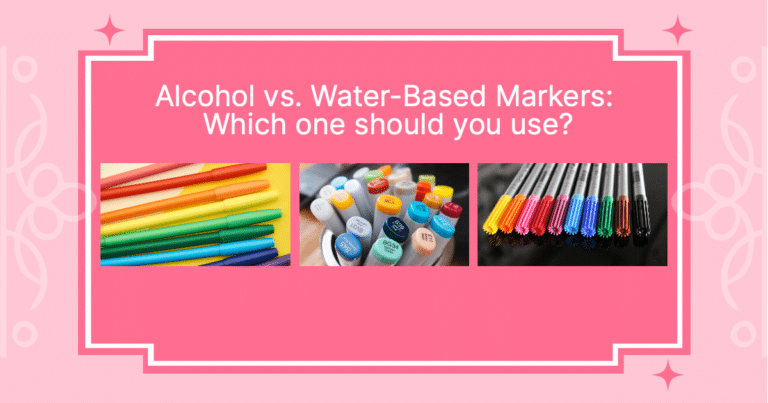As an artist, choosing the right marker type can be the difference between a successful project and a disappointing one. When it comes to markers, there are two main types: alcohol vs water based markers. Each type has its unique features and benefits, and it’s essential to understand the differences and choose the right marker for your project. In this article, we will explore the differences between alcohol-based and water-based markers and provide recommendations for which marker type to use.
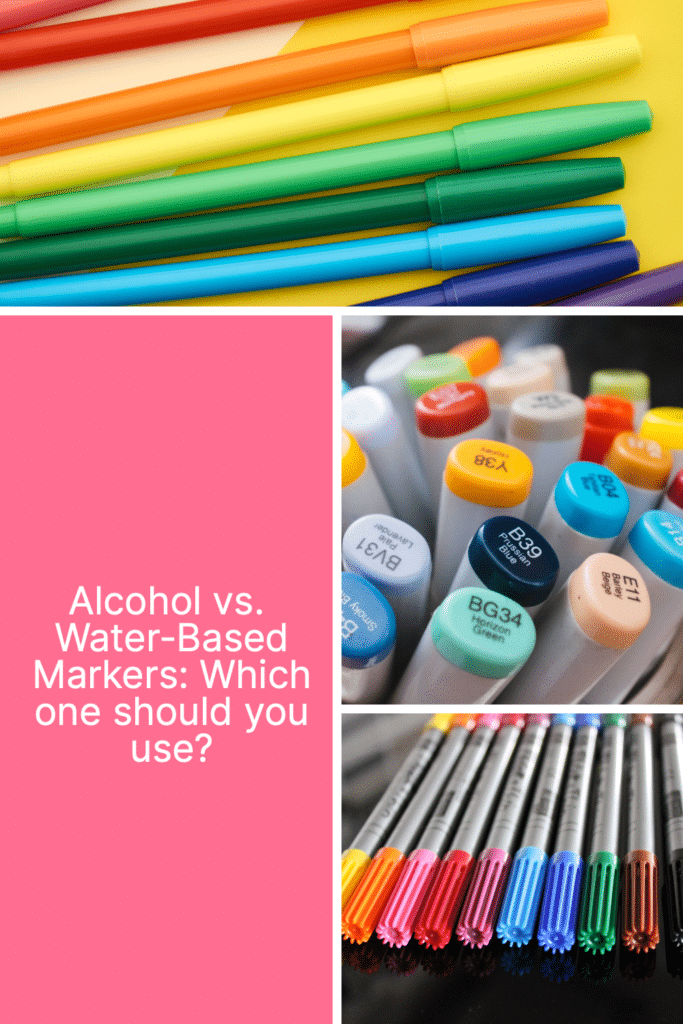
Watercolor vs. Alcohol Markers: Major Differences Between Them
Watercolor and alcohol markers are two popular mediums for artists, and while they may look similar at first glance, they have some key differences.
The main difference between watercolor and alcohol markers is the type of solvent used to suspend the pigment. Watercolor markers use a water-based solvent, while alcohol markers use an alcohol-based solvent. This difference affects the way the markers blend, dry, and interact with other mediums.
Watercolor markers tend to be more versatile, as they can be used for a variety of techniques such as wet-on-wet, wet-on-dry, and dry brushing. They are also easier to blend, as they can be activated with water or a wet brush to create a watercolor effect. Watercolor markers can be used on a variety of surfaces, including watercolor paper, mixed media paper, and an illustration board.
Alcohol markers, on the other hand, are better for creating bold and vivid colors that dry quickly and do not bleed or smudge. They are great for creating smooth gradients and blending and can be layered to create depth and dimension. Alcohol markers are often used for illustrations, graphic design, and product design. They are also commonly used for coloring stamps and creating detailed line work.
Overall, the choice between watercolor and alcohol markers depends on the specific project and desired outcome. Watercolor markers are great for creating a soft and organic effect, while alcohol markers are ideal for creating bold and vivid colors with precise lines and blending. Both mediums have their place in the world of art and design, and it’s up to the artist to experiment and decide which one is best for their work.
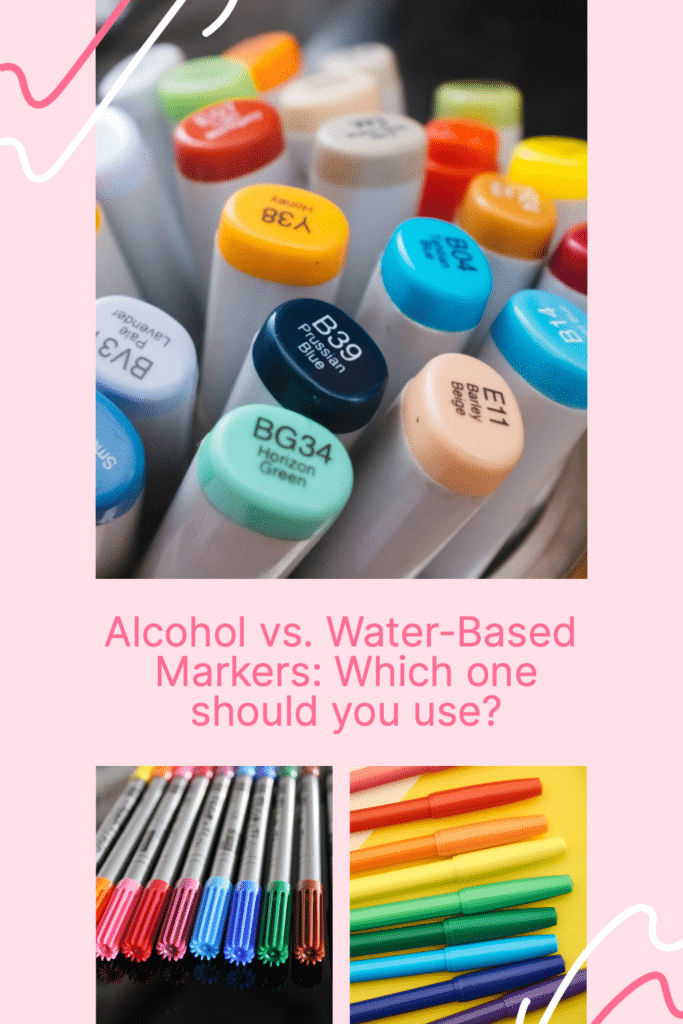
Color Comparison (Alcohol vs Water Based Markers)
In my experience, alcohol-based markers tend to be brighter and more vibrant than water-based markers. The pigment used in alcohol-based markers creates a more saturated color that pops off the page, while water-based markers provide a more subtle and pastel-like appearance. Both types of markers have their place in art, depending on the desired effect.
When it comes to marker sets, the range of colors can vary greatly between brands and sets. For example, the Tombow ABT PRO Alcohol Markers offer a wide range of colors, from bright neon hues to deep earth tones.
The alcohol-based formula allows for smooth blending and layering, making it easy to create depth and contrast within a color range. These markers are also refillable, making them a more eco-friendly option in the long run.
On the other hand, the Winsor & Newton Promarker Watercolor Markers come in a wide range of colors that have a more subdued and natural tone.
These markers are ideal for creating soft washes of color and blending to create a watercolor effect. Since they are water-soluble, they can also be used with a wet brush to create gradients and subtle variations within the colors.
Bleeding
Color bleeding or blooming is the effect where the ink or pigment of the marker spreads out on the paper, creating a softer or more diffuse edge. This can be a negative effect when you want to create clean and crisp lines, but it can also be a positive effect when you want to create a more organic or watercolor-like effect.
In my experience, alcohol-based markers tend to bleed less than water-based markers. The quick-drying formula of alcohol-based markers allows for more precise lines and less bleeding, but it can also make it more difficult to achieve a blooming effect. However, if you want to achieve a blooming effect with alcohol-based markers, you can use a colorless blender or rubbing alcohol to activate the ink and create a softer edge.
On the other hand, water-based markers are more prone to bleeding and blooming, which can have a positive or negative effect depending on the desired outcome.
To achieve a blooming effect with water-based markers, you can use a wet brush or spritz the paper with water before applying the marker. This will create a more diffuse edge and can be especially effective when creating backgrounds or creating a watercolor effect.
Overall, the choice between alcohol and water-based markers and the decision to use a bleeding or blooming effect depends on the specific project and desired outcome.
While alcohol-based markers are generally better for creating precise lines and less bleeding, water-based markers offer a more organic and watercolor-like effect with greater potential for bleeding and blooming. Experimentation and practice are key to achieving the desired effect with both types of markers.
Different Brush Pen Tips
When it comes to markers, the type of brush tip or nib tip shape can greatly affect the final result.
Alcohol-based markers typically have a chisel tip and a fine tip, while water-based markers can come in a variety of shapes, including brush tips, bullet tips, and chisel tips.
Brush Tip
A brush nib is a flexible brush tip, tapered tip that resembles a brush. This type of tip is ideal for creating sweeping strokes and thin lines, as well as for blending colors together.
For example, a brush tip can help you quickly cover the space and blend the colors if you’re coloring in a large area. I’ve used brush tip water-based markers for lettering, and it’s helped me get smooth transitions and gradients.
A Bullet Tip
A bullet tip, or a round tip, has a pointed, rounded tip that creates thin, precise lines. This type of tip is perfect for outlining, adding detail, and filling small areas.
For instance, if you’re working on a detailed drawing or coloring book, a bullet tip can help you create intricate designs with ease. I’ve found that bullet tip alcohol-based markers are great for coloring tiny details like hair strands or whiskers.
Chisel Tip
A chisel marker tip has a flat, angled edge that can create thick and thin lines depending on how it’s held. This type of tip is versatile and can be used to fill large areas, create straight lines, and make diagonal strokes.
For example, a chisel tip can help you create sharp, clean lines if you’re working on a coloring book with geometric shapes. I’ve used chisel tip alcohol-based markers to fill large areas like the sky in a landscape.
Overall, the choice between alcohol-based and water-based markers and the tip shape depends on your preferences and needs.
Experiment with different tips and brands to find the best ones for your projects.
Blendability – Alcohol vs. Water Based Markers
When it comes to blending, both alcohol and water-based markers have their own unique qualities.
An alcohol marker tends to blend more smoothly and evenly, while water based ink markers can be more challenging to blend.
An Alcohol based marker has a quick-drying formula, unlike water based markers, that allows it to blend seamlessly. They can be blended by layering colors, using a colorless blender, or using rubbing alcohol.
I’ve found that blending alcohol-based markers can be a lot of fun and quite satisfying, as the colors blend together smoothly and create a professional-looking finish.
Blending Tip: Blending alcohol-based markers is to use a lighter color as a base and layer darker colors on top, using the lighter color as a blending agent.
Water-based markers, on the other hand, require more patience and skill to blend. Since they are water-soluble, they can be blended by using a wet brush or by applying water to the paper before coloring.
I’ve found that blending water-based markers requires a lot of experimentation and practice, as it can be tricky to achieve the desired effect.
Blending Tip: One tip for blending water-based markers is to work on wet paper to create a softer, more blended look.
Overall, both alcohol and water-based markers can be blended successfully with a bit of patience and practice.
However, if you’re looking for a marker that is easier to blend and creates a more even finish, alcohol-based markers are the way to go.
If you prefer a softer, more watercolor-like effect, water-based markers can provide a beautiful result with a bit more effort. Don’t be afraid to experiment with both types of markers and blending techniques to find the method that works best for you!
Our Recommendation: Best Alcohol-Based Markers
**This page may contain affiliate links to products I have used or recommend. If you purchase something from this page, I may receive a small percentage of the sale at no extra cost to you.**
Best Alcohol Markers for Professionals
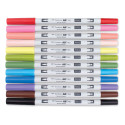
The Tombow ABT PRO Alcohol Markers are some of the best alcohol-based markers for professionals. They have a dual tip design with a fine point and a brush tip, which allows for precise line work and flexible brush strokes. The ink is also quick-drying, which makes it ideal for layering and blending.
One of the standout features of the Tombow ABT PRO markers is the color range. There are 107 colors in the set, including a range of skin tones and grays for shading and blending. The colors are also blendable, allowing for smooth transitions between shades and creating a variety of color effects.
Another great aspect of the Tombow ABT PRO markers is the ergonomic design. The triangular barrel shape is comfortable to hold and prevents the marker from rolling off the table. The cap design also ensures a secure fit, preventing the markers from drying out.
Overall, the Tombow ABT PRO Alcohol Markers are an excellent choice for professionals who are looking for a versatile and high-quality marker set. With a wide range of colors (you can also choose to buy just one marker in your desired color at a time), blend-ability, and ergonomic design, these markers are sure to meet any artist’s or designer’s needs.
Best Alcohol Markers for Students

The Ohuhu Markers, 48-color Double Tipped Alcohol Markers, are the best alcohol markers for students. One of the main reasons for this is their affordability. As a student, it can be difficult to justify spending a lot of money on art supplies, but the Ohuhu markers provide a high-quality option at an affordable price.
Another great feature of the Ohuhu markers is the color range. With 48 colors to choose from, students have many options to work with and can experiment with various color schemes. The markers are also dual-tipped, with a fine and chisel points, allowing for detailed work and broad strokes.
The ink in the Ohuhu markers is also quick-drying, which makes them ideal for layering and blending. The colors are also vibrant and long-lasting, providing a professional look to any project.
Finally, the Ohuhu markers are designed to be durable and long-lasting, essential for students to use them frequently. The caps are secure and prevent the markers from drying out, and the barrels are sturdy and comfortable to hold.
Overall, the Ohuhu Markers, 48-color Double Tipped Alcohol Markers are an excellent choice for students who are looking for a high-quality and affordable marker set. With a wide range of colors, dual-tipped design, and durability, these markers are sure to meet the needs of any student artist.
Our Recommendation: Water Based Markers
Best Water Based Markers for Professionals

The Winsor & Newton Promarker Watercolor Markers are the best water based, artist-quality markers for professionals. One of the standout features of these markers is the watercolor-like effect they provide. They blend seamlessly and offer a soft, subtle appearance perfect for creating a watercolor effect in the artwork. If you are looking for a superb water-based marker, these are for you.
The Promarker Watercolor Markers have a dual tip design with a fine point and a broad chisel tip, which makes them versatile and perfect for different techniques. The ink is also quick-drying, which makes it easy to layer and blend colors without worrying about smudging or bleeding.
The color range in the Promarker Watercolor set is also impressive. There are 36 colors to choose from, including a range of pastels and bright colors that can be blended to create an endless array of shades. The colors are also vibrant and long-lasting, providing a professional finish to any project.
Another great aspect of the Promarker Watercolor Markers is their durability. The barrels are sturdy and comfortable to hold, and the caps are secure, preventing the markers from drying out over time.
The Winsor & Newton Promarker Watercolor Markers are an excellent choice for professionals who are looking for a water-based marker set that provides a watercolor effect. With a range of colors, dual tip design, quick-drying ink, and durability, these markers are sure to meet the needs of any professional artist or designer.
The Tombow Dual Brush pens are another great water based option. These dual-tipped markers have a flexible brush tip on one end for creating broad strokes and fine lines, and a fine tip to help you easily create lighter shades and precise detailing.
Best Water-based Markers for Kids

In my experience, the Crayola Ultra Clean Washable Markers for School are the best water-based markers for kids. One of the main reasons for this is their washability. As a parent or teacher, it can be stressful to let kids use markers because of the mess they can create. But with the Crayola Markers, you don’t have to worry about stains or ruined clothing. The ink washes easily off of skin, clothes, and even painted walls, making clean-up a breeze.
Another great feature of the Crayola Ultra Clean Washable Markers is the color range. The set comes with 10 classic colors that kids love to work with, and the bright and vibrant ink. The markers are also easy for kids to grip, which makes them perfect for little hands.
The ink in the Ultra Clean Washable Markers is also non-toxic, which is important for parents and teachers who want to ensure the safety of their children. Kids can use the markers without any harm to their health, and parents can feel confident in their choice of art supplies.
Finally, the Ultra Clean Washable Markers are designed to be durable and long-lasting, which is important for kids who may be using them frequently. The caps are secure and prevent the markers from drying out, and the barrels are sturdy and resistant to breaking.
Overall, the Crayola Ultra Clean Washable Markers for School are an excellent choice for kids who are just starting out with markers. With their washability, color range, non-toxic ink, and durability, these markers are sure to provide hours of creative fun for kids while giving parents and teachers peace of mind.
Which markers are best for coloring? (Alcohol based markers vs water based markers.)
If you’re new to coloring and looking to invest in markers, you may be wondering which type is best for you: alcohol or water-based markers? It’s a common question; the answer depends on your preferences and the type of coloring you plan to do.
Alcohol Markers for Coloring
Alcohol-based markers are known for their bright, bold colors and smooth blend-ability. They’re great for creating vibrant illustrations and designs, and the ink dries quickly, which makes them ideal for layering and blending colors. Alcohol markers are also long-lasting, so you won’t have to worry about the ink fading over time.
Water Based Markers for Coloring
On the other hand, water-based markers offer a more subtle, pastel-like effect that’s perfect for creating a watercolor effect in your artwork. They’re easy to blend and layer, making them ideal for creating gradients and shading. Water-based markers are also non-toxic and washable, making them a great choice for younger artists or anyone concerned with safety and easy cleanup.
Ultimately, the choice between alcohol and water-based markers comes down to personal preference and the coloring you plan to do. If you want bold, bright colors and smooth blend-ability, alcohol markers may be the way to go. But if you’re looking for a more subtle, watercolor-like effect, water-based markers may be the better choice.
Regardless of which type you choose, investing in a good quality set of markers can make a massive difference in the quality of your artwork. So take your time, research, and choose the markers that feel right for you and your creative vision.
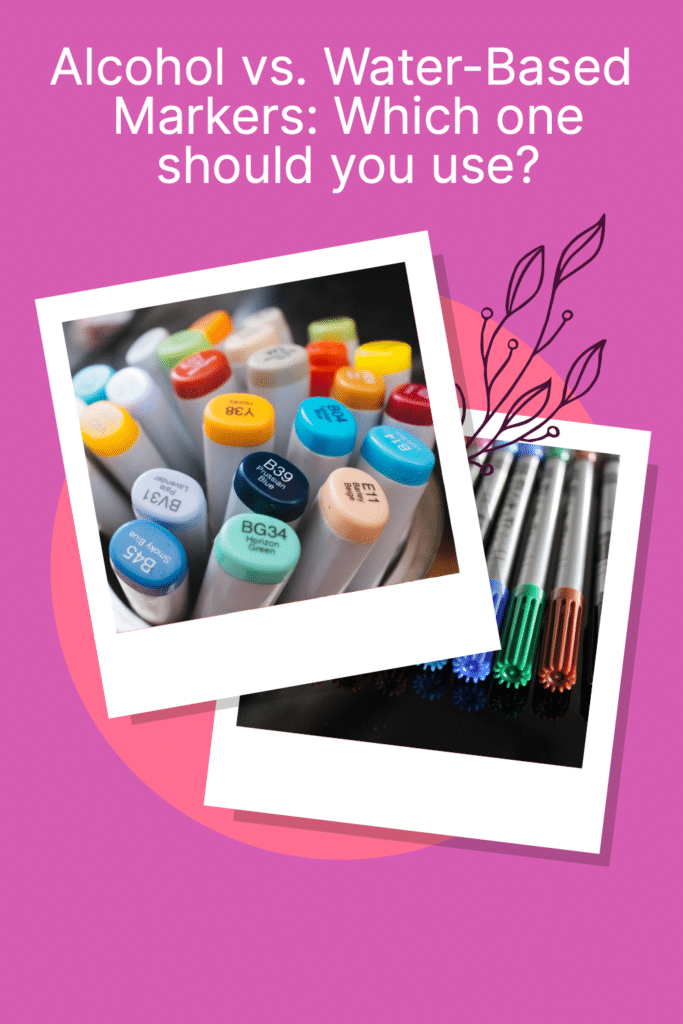
Conclusion
The choice between alcohol and water-based markers ultimately depends on your personal preferences and the type of coloring or artwork you plan to do. Alcohol markers are great for creating bold, vibrant designs and illustrations, while water-based markers offer a more subtle, watercolor-like effect. When it comes to coloring pages, mixed media art or even bullet journals, both types of markers can be used to add color, texture, and personality to your pages.
Happy art-making 🙂
Other articles you may enjoy…
A List of the Best Junk Journal Supplies for 2023
How to Organize Art Supplies | The Ultimate Guide
The 10 Best Bags for Carrying Art Supplies to Class
